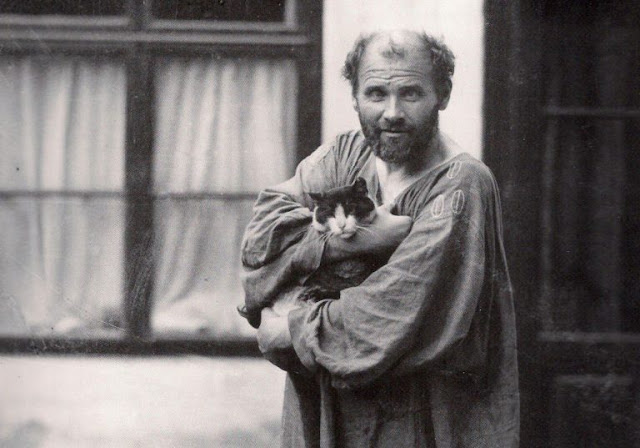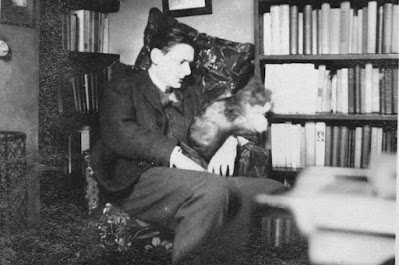Happy Caturday! Emotional Support Cats: Independent Operators of the Heart
The decadent symbolist painter, Gustav Klimt was inseparable from his cats. They roamed his studio like furry muses, often curling up on velvet while he painted gold-laced skin and mythic women. Klimt lived as privately as his cats — and created work that purred with sensual defiance.
Klimt let his cats climb on canvases, spill paint, and nap in silks. He never scolded them — he said they “understood texture.”
Dogs are loyalists. Cats are curators. A dog wants your approval. A cat wants you to meet their standards. And when they do choose you? It’s spiritual. It’s selective. It’s elite. Cats don’t offer affection indiscriminately. Their love is a velvet-gloved crown on your head. And their gaze — slow-blinking, discerning, ancient — can quiet even the loudest mind. That’s why emotional support cats aren’t assigned — they arrive. On windowsills. In shelters. Or sometimes, uninvited and unbothered, at your door with a dead bird and no plans to leave.
“Time spent with cats is never wasted.” — Sigmund Freud, possibly after being ignored by one.
The Headbutt (a.k.a. Boop of Devotion): Forehead contact is sacred in feline culture.
The Gift Drop: A dead bug. A sock. A leaf. It’s their love language, not yours.
Sleeping On You: That’s not just comfort. That’s trust.
Yowling in the Night: Love, filtered through primal existential dread.
And let’s be clear — the lap cat is not a myth. It’s a blessing. Some breeds are naturally cuddly and that's cool, but many rescues turn into heat-seeking missiles once trust is earned. It is unconditional and it is usually forever.
Papa Hemingway didn’t collect trophies — he collected polydactyl cats. His Key West home became a feline sanctuary, with dozens of six-toed cats he called “pillow-footed” companions. He claimed cats had more integrity than most men.
In the last few decades we have seen cats rise in popularity and it seems the public is finally catching on and they are finally getting what we cat lovers always knew. Cats have a capacity for deep love and devotion. People are even inventing ways to borrow one's energy for an hour or two. There’s a reason cat cafés have quietly overtaken therapy for some people. In 30 minutes, you can sip a lavender latte, snuggle a rescue tabby, and realign your central nervous system. Purring is vibrational. Scientific. Grounding. Studies show cat purrs may help lower stress and even heal tissue. But more importantly, they make you feel seen without needing to explain yourself — the holy grail of emotional support.
While every cat is an individual, certain breeds are naturally attuned to human emotions:
Ragdolls: Floppy, affectionate, and terrifyingly docile. They go limp like a toddler in Target.Maine Coons: Gentle giants with chirpy voices and giant paws. Surprisingly clingy.
Siamese: Loud, opinionated, loyal. Will follow you into the bathroom and critique your life choices. My godfather is partial to Siamese and they chat constantly. He had 9 at one time and is now down to 3 elders, a teenager and 2 kittens. Guess who inherits them? They are spoiled, loving and will yell at him when he's on Zoom and it is time to eat or not. Maybe they want a treat or maybe they want to go to the yard he has in NYC. He's been there forever and I believe people would murder him for his apartment but that's another topic. His cats are lucky they cat sun safely and then come back in.
Russian Blues: Reserved but sweet. Like an introvert who brings you tea.
Bombays & Burmese: Social, sleek, and ultra-cuddly. Born to be lap furniture.
***
There’s also a special kind of emotional support cat: the unsolicited houseguest. You know them. You didn’t adopt them. They adopted you. They were just there one day — on your porch, under your car, watching you through a window like a feline debt collector. And you let them in. They never left. These cats come with old souls and mysterious origins. They know things. They felt your sadness. And they showed up. Cats are not accessories. They’re mystics. Soft-footed philosophers. Velvet-bodied introverts who double as spirit guides.
***
T.S Eliot. Poet. Prude. Cat deviant. His Old Possum’s Book of Practical Cats gave us a taxonomy of feline personalities — from Macavity the criminal to Mr. Mistoffelees the trickster. It was absurd, brilliant, and deeply affectionate.
***
There’s a moment — maybe you’ve had it — when you’re spiraling on the couch, unsure whether you’re sad, hungry, or clinically unwell. And your cat, previously napping on a windowsill with their leg at a disturbing angle, hops down, sits chest-to-chest, and just stares at you. They don’t do anything dramatic. They don’t fetch your medication or send a text. They simply witness. And that’s often what we need more than advice or affirmation: someone — or some feline — to hold space with their body and say, “You are not invisible.”Cats are, in this way, natural trauma companions. They track emotional barometric pressure. They anchor the air. They’re not going to fix your depression — but they will lay directly on it.
“A cat is a puzzle for which there is no solution.” — Hazel Nicholson
There’s a reason many therapists, hospice workers, and trauma healers end up with multiple cats: rescue cats are born clinicians.These are not blank-slate kittens. These are creatures who’ve survived loss, fear, hunger, abandonment — and still purr. They know the arc of healing. They’re not scared of your silence. They understand when you eat cereal in the dark and cry over something you can’t name. They’ve been there. Some might sit five feet away, politely aloof. Others burrow into your sternum and refuse to budge. Both are offering presence. One is just more boundary-respectful than the other.
***
The surrealist Japanese novelist, Haruki Murakami has cats all over his work — appearing as messengers, spirits, or just aloof truth-tellers. In interviews, he often says cats “exist outside of time.” He’s owned many — and lets them come and go freely, just like his plotlines.
In Kafka on the Shore, a cat speaks. In The Wind-Up Bird Chronicle, a cat disappears — and reality collapses.
***
Our feline companions often mirror our internal states. Anxious? They get twitchy. Calm? They melt. If you’re spiraling, they may just leap onto your keyboard, stare you down, and reorient your entire nervous system in 0.2 seconds with a single tail flick and judgmental blink. They also model unapologetic self-care. Hungry? They ask. Tired? They nap. Overstimulated? They leave. Need affection? They demand it — but only on their terms. Honestly, they could teach a masterclass in boundaries. And maybe that’s part of their magic. Emotional support cats don’t just soothe us — they train us. In consent. In presence. In recognizing when enough is enough.
***
French author, performer, and sensualist. Colette didn’t just own cats — she wrote as one. Her essays on cats were intimate, fierce, and often erotic in their metaphors. She believed cats were women’s closest emotional companions — silent witnesses to feminine power and exhaustion.
better at sex and more honest in grief than most men.
When the Cat Is Gone, the Room Echoes
Anyone who’s lost a beloved cat knows the cavernous silence that follows. No purring against your thigh. No gentle thunk of them leaping onto your bed like they pay rent. No lazy stretch and squint as the sun moves across the floor. The room becomes a little colder. The couch feels emptier. The world, slightly less enchanted. Because these creatures — silly, fussy, intuitive — become woven into our healing timelines. They are the silent chapters in our recovery stories. The ones who saw the breakdown, the breakthrough, the weird crying during documentaries, and never once asked why. They don’t need to. They were just there. And sometimes that’s the most radical act of all.
And they never charged a co-pay.




















Comments
Post a Comment